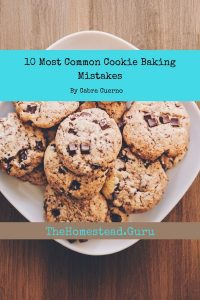Trial and Error: Common Cookie Baking Mistakes
Experimenting with baked goods will definitely result in some disasters. Common cookie baking mistakes can lead to a whole array of possible outcomes. Sometimes to get the perfect cookie though, one must go through the process of trial and error.
Baking is fun and so is experimentation. I encourage you to combine the two and see what delicious discoveries you come across! However, I thought I’d help you avoid the most common mistakes sure to lead to undesirable results.
I experimented with this Nestlé Toll House chocolate-chip cookie recipe. Here’s what I found.
1. Be careful of how much you mix the batter
Over mixing of the butter and sugar specifically (or over creaming, in baking-speak) resulted in a runnier batter. As a result, the cookies came out light and airy, and I was able to taste the butter more prominently in this batch than in others. They turned out nice and evenly browned.
Over creaming occurs when you combine the butter, sugar, and vanilla. Over mixing, on the other hand, is when you mix too much after adding flour. This can lead to a tough textured cookie.
2. Make sure you’re using the right leavening agent in the right amounts
Using too much baking powder resulted in a too chewy too sticky cookie — the kind of chewy that causes your teeth to stick together a little when you chomp down.
The cookies made with too much baking soda had a dark ring around the outside and a lighter tan colored inside. These cookies had a chemical-like artificial flavor.
Whether you use one or the other depends on the specific cookie recipe, so make sure you double-check and figure out your preference!
3. Too much flour and your cookie batter won’t spread
This is baking 1010. Be careful when measuring out your flour. Packing the flour—tapping the measuring cup on the counter or pushing the powder down with a spoon—will result in too much flour.
If you make this error, your cookies will likely have a solid cookie flavor but will be fluffier than any cookie ought to be. They are likely to be dry inside, but not dense.
4. Too little flour will make your cookies crisp and thin
These cookies spread too much! They wound up being nearly the size of my hand, and though their super thin, brown appearance initially made me think I had burned them, they did not taste burnt at all.
The entire cookie was crispy, but the chips stayed intact.
If you like a thin and crispy cookie, this method yields an ideal cookie. If you’re looking for a traditional cookie texture measure your flour carefully!
5. Mixing all the ingredients at once may save time, but it compromises the texture of the cookies
I mixed the flour, sugar, vanilla, salt, baking soda, egg, and butter into one bowl.
I got air bubbles everywhere, and the cookies weren’t so pretty. They were bumpy instead of cohesive and uniform, and it looked like there were tiny clumps of ingredients in them. Though the texture got weird, the flavor remained very good.
6. Don’t forget the eggs!
The cookies baked without eggs were really crumbly. They fell apart as I loaded the batter onto the baking sheet.
When I pulled them out of the oven, they had melted out from the middle. They were actually very beautiful… rustic looking.
They had a bite to them that was a little chewy but dry. An interesting effect of leaving out eggs is that you can taste the salt prominently. These were the saltiest cookies by far.
7. On the other hand, using too many eggs gives a spongy, cake-like texture
This batch was basically a tray of small cakes. They looked and felt like madeleine cookies.
There was barely any crunch on the cookies; they were just spongy all over. This is another pretty common cookie baking mistake.
8. Bready cookies need more sugar
Not using enough sugar resulted in dry and bready cookies. They were not chewy at all, and they puffed upward in the center.
And though the flavor was good, I was not able to taste the vanilla as much as I could in the other cookies. The texture was similar to a not-so-hard scone.
9. Too much butter makes cookies turn out too oily
This batch of cookies was cakey in the middle, but also airy throughout, with crispy edges. They were yellow and slightly puffy in the middle, and brown and super thin around the perimeter.
Using too much butter obviously makes the cookie’s buttery. The cookies melt apart in your mouth very quickly.
10. Using too little butter leads to a dry puffy cookie
These cookies were most similar to the batch that included too much egg. These just puffed up differently—they had more of a muffin top.
But this batch tasted really good. I was able to identify the vanilla and enjoy the classic cookie flavor that comes with it.
It was a puffy cookie that felt airy in my hand. The bottom of the cookie looked the same as the cookie with too much egg; more like a madeleine than a chocolate-chip cookie.
By making slight alterations to a cookie recipe, you can make tons of different cookies
It is interesting how even slightly changing the amount of flour you use can drastically change your cookie outcomes. If you find you have made one of these mistakes while trying to make the perfect batch, don’t sweat it. Baking is a learning process. And learning from your mistakes means that baking your next batch of cookies will be… a piece of cake.
Looking for gluten-free cookie options? Check this link to Gluten-Free Peanut Butter Cookie Recipe.




